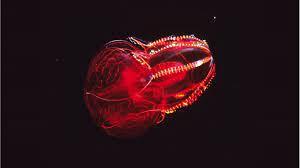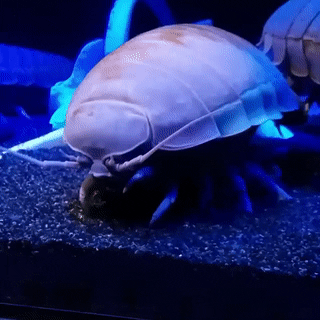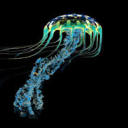Hula Skirt Siphonophore

Hula Skirt Siphonophore
Physophora hydrostatica
The Hula Skirt Siphonophore a deep sea siphonophore that is found between 700 m to 1000m. It is made of a colony of hundreds tiny zooids. The top portion of the colony holds the swimming bells, which allow the colony to move. The bottom of the siphonophore holds the orange ‘hula skirt,’ which is full of stinging tentacles.
Photo link : https://twitter.com/montereyaq/status/1162068535331311617?lang=da
More Posts from Bioluminescentoceangoddess and Others


Black-devil anglerfish
Melanoncetus johnsoni
The Black-devil anglerfish is a skilled predator that lurks in the darkness. It uses a bioluminescent organ, a top its head, to lure unsuspecting prey into its jaws. Even though these fish are terrifying to look at, they are about the size of a grape fruit. To save energy, they remain immobile in the water, yet they can detect even the slightest vibrations. Since finding a mate is hard at this depth, male fish will attach themselves to a female and slowly dissolve into her tissue; so she is able to use the sperm the male provides at any time. In addition, this is the fish that tried to eat Marlin and Dory in “Finding Nemo.”
Photo credit: https://underthevastblueseas.tumblr.com/post/40882487364/this-female-black-devil-anglerfish-with-her-flabby
https://www.pinterest.fr/pin/574631233709001328/

Sea Angel
Cliopsis krohni
The Sea Angel is a tiny snail that is only 4 cm in length and found at depths as deep as 1500 m. Even though it is small, it is a viscous predator. It hunts other midwater snails using a structure called a radula. Unlike other snails, the Sea Angel’s mouth is located on top of its head. It also uses swimming “wings” to propel through the water.
Photo Source: http://seaslugsofhawaii.com/species/Cliopsis-krohni-a.html
An amazing glowing ctenophore!


Bloody-belly comb jelly
Lampocteis cruentiventer
The Bloody-belly is a 16 cm ctenophore that is found at depths 700 m to 1200m. It is crimson red in color and appears black in the deep ocean. However, the jelly has the ability to emit a different color. Furthermore, it uses highly iridescent ctenes to propel through the water.
Photo credit: https://laughingsquid.com/bloody-belly-comb-jelly/
https://www.reddit.com/r/deepseacreatures/comments/2j1717/bloodbelly_comb_jelly_lampocteis_cruentiventer/


Deep Sea Arrow Worm
Eukrohnia hamata
Arrow worms are small, predatory marine worms that consume copepods, ostracods, and larvae. They resembles a clear, ink pen whizzing through the dark sea. Furthermore, they are found primarily in the Artic Ocean between 700m to 1200m. The picture on the bottom is its head. They have 8 hooks, which are used to grab prey and 25 posterior teeth. Even though the arrow worms are terrifying up close, they are only 4.5 cm in size.
Photo credit: http://www.arcodiv.org/watercolumn/chaetognaths/Eukrohnia_hamata.html


Physonect Siphonophore
Nanomia cara
The Physonect siphonophore has tiny, bubble shaped sacs that are filled with gas. The sacs are called pneumatophores and help this creature move through the deep ocean. It also has venomous tentacles that stun prey and over eighty stomachs. There are numerous amounts of these strange creatures along the east coast, and they have cause some fisheries to collapse. Furthermore, they can be found at depth between 400m to 1000m.
Photo credit: http://www.seawater.no/fauna/cnidaria/cara.html
https://www.mindenpictures.com/stock-photo-siphonophore-hydrozoan-cnidarian-nanomia-cara-atlantic-nectophores-naturephotography-image90194961.html


Cockatoo Squid
Galiteuthis phyllura
The Cockatoo squid is a highly-specialized oddity of the deep ocean and found at depths between 300 to 1400 m. It is completely transparent, except for its eyes. It also has bioluminescent photophores that are directed downward: this makes it difficult for deep sea predators to see the Cockatoo Squid. It was named after the Cockatoo because it holds its tentacles above its head, resembling the bird. The Cockatoo squid can also get fairly large with adults reaching lengths of 2.7 meters (over 6 ft.)
Photocredit: https://www.americanscientist.org/article/at-home-in-the-dark
https://www.pinterest.com/pin/28710516347382519/


Giant Isopod
Bathynomus kensleyi
The Giant Isopod is an unsettling deep sea creature that crawls along the ocean floor scavenging for animal remains and detritus. These invertebrates are part of phenomenon known as abyssal gigantism, which is the tendency for deep-sea dwelling invertebrates to be larger than their shallower-water counter parts. The Giant Isopod is found between 310m to 2140m in the ocean.
Photo credit
https://seatrench.tumblr.com/post/615873390014791680/giant-isopod-bathynomus-sp-source
https://alchetron.com/Giant-isopod


Atolla Jelly
Atolla wyvillei
The Atolla Jelly is a fiery, red jellyfish that has an extraordinary display of bioluminescence. When the jelly is attacked, it uses bioluminescence to produce thousands of vibrant, blue flashes; the blue flashes act as an alarm, which draws in bigger predators and warns prey. The jelly can be found at depths between 600 m to 1500m, and it also has a long hypertrophied tentacle that aids in reproduction.
Photo credit: https://en.wikipedia.org/wiki/Atolla_jellyfish
https://en.wikipedia.org/wiki/Atolla_jellyfish


Pigbutt worm
Chaetopterus pugaporcinus
The Pigbutt worm or the flying buttocks of the sea is spotted floating between 965 m to 1300 m in the deep ocean. It is actually a polychaete (polly-keet) worm species that burrows in the ground as an adult, and floats around the ocean as a baby. The worm feeds itself : by creating a balloon of mucus; collecting particles on the mucus; and then consuming the particles. It is the rarest and thickest worm in the deep ocean, for only ten have been spotted.
Photocredit: https://roaring.earth/pigbutt-worm/

Vampire Squid
Vampyroteuthis infernalis
Even though the Vampire Squid is named after a notorious monster, this gentle creature does not live up to its name. It is only a foot long and occupies depths between 650m to 1500m in the deep ocean. Unlike other squids, it has reduced musculature and collects particles in the water column. However, it is capable of huge bursts of speeds. It uses bioluminescence to confuse both predators.
Photo credit: https://ocean.si.edu/ocean-life/invertebrates/vampire-squid-hell
-
 elliecoprion liked this · 1 month ago
elliecoprion liked this · 1 month ago -
 mycellpics liked this · 1 year ago
mycellpics liked this · 1 year ago -
 zenidogsworld liked this · 1 year ago
zenidogsworld liked this · 1 year ago -
 stardustandmoonflowers liked this · 1 year ago
stardustandmoonflowers liked this · 1 year ago -
 thatlittleocean reblogged this · 2 years ago
thatlittleocean reblogged this · 2 years ago -
 opalescent-magic reblogged this · 2 years ago
opalescent-magic reblogged this · 2 years ago -
 forgetfullace liked this · 2 years ago
forgetfullace liked this · 2 years ago -
 gingertomcat liked this · 2 years ago
gingertomcat liked this · 2 years ago -
 hairlice reblogged this · 2 years ago
hairlice reblogged this · 2 years ago -
 spooky-alien liked this · 2 years ago
spooky-alien liked this · 2 years ago -
 yourlocalshapeshifter liked this · 2 years ago
yourlocalshapeshifter liked this · 2 years ago -
 ihismyinitials liked this · 2 years ago
ihismyinitials liked this · 2 years ago -
 psychoticsomatics reblogged this · 2 years ago
psychoticsomatics reblogged this · 2 years ago -
 imjustvibingyaknow reblogged this · 2 years ago
imjustvibingyaknow reblogged this · 2 years ago -
 imjustvibingyaknow liked this · 2 years ago
imjustvibingyaknow liked this · 2 years ago -
 dragon-teapot liked this · 2 years ago
dragon-teapot liked this · 2 years ago -
 taletreader liked this · 2 years ago
taletreader liked this · 2 years ago -
 saltmatchescandlewax reblogged this · 2 years ago
saltmatchescandlewax reblogged this · 2 years ago -
 anemonether liked this · 2 years ago
anemonether liked this · 2 years ago -
 nowhere-error-101 liked this · 3 years ago
nowhere-error-101 liked this · 3 years ago -
 franklin-mp3 reblogged this · 3 years ago
franklin-mp3 reblogged this · 3 years ago -
 darknovalatte liked this · 3 years ago
darknovalatte liked this · 3 years ago -
 thehiddenbaroness reblogged this · 3 years ago
thehiddenbaroness reblogged this · 3 years ago -
 amethysthorizon reblogged this · 3 years ago
amethysthorizon reblogged this · 3 years ago -
 thomasbrisenio reblogged this · 3 years ago
thomasbrisenio reblogged this · 3 years ago -
 kaktusbird reblogged this · 3 years ago
kaktusbird reblogged this · 3 years ago -
 redwolf1999 liked this · 3 years ago
redwolf1999 liked this · 3 years ago -
 aganatis liked this · 3 years ago
aganatis liked this · 3 years ago -
 leaping-laelaps liked this · 3 years ago
leaping-laelaps liked this · 3 years ago -
 macla539ac liked this · 3 years ago
macla539ac liked this · 3 years ago -
 colors927 reblogged this · 3 years ago
colors927 reblogged this · 3 years ago -
 wellflowers liked this · 3 years ago
wellflowers liked this · 3 years ago -
 stingobingo reblogged this · 3 years ago
stingobingo reblogged this · 3 years ago -
 sothatidostuff reblogged this · 3 years ago
sothatidostuff reblogged this · 3 years ago -
 shiny-aesthetic liked this · 3 years ago
shiny-aesthetic liked this · 3 years ago -
 hazeabiran reblogged this · 3 years ago
hazeabiran reblogged this · 3 years ago -
 fish-fido liked this · 3 years ago
fish-fido liked this · 3 years ago -
 blueorandas reblogged this · 3 years ago
blueorandas reblogged this · 3 years ago -
 blueorandas liked this · 3 years ago
blueorandas liked this · 3 years ago

Bioluminescence is a chemical reaction that produces light. Many deep sea animals use bioluminescence. This blog is dedicated to educating the public about the amazing creatures that thrive in the deep sea.
57 posts